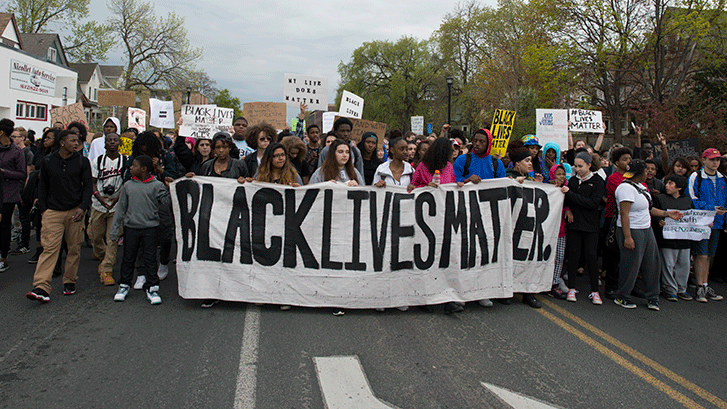Teaching Religion as Anti-Racism Education
There is no way to deeply consider religion—its history, definition, impact, danger, and promise—without also thinking about the construction of race. And yet, addressing race, racism, and white privilege in the religious studies classroom is fraught with challenges for faculty and students alike. These tensions have been exacerbated by the contemporary political climate in the United States, but ultimately stem from much deeper historical roots involving settler colonialism, the genocide and forced relocation of indigenous populations, and the enslavement of peoples of African descent. Addressing this maligned history in the United States as well as different iterations of it around the world, considering its contemporary consequences, and envisioning possible futures is part of the important work taking place in religious studies classrooms.
Taking this into account, this Spotlight issue is dedicated to sharing a rich variety of pedagogical approaches to teaching religion as anti-racism education. Questions germane to this topic include: How can we break the silence so many of us have been disciplined into maintaining on the subject of race and racism, and open up spaces for meaningful classroom conversations that move beyond trying to say the right thing? How can we best guide students to take risks in talking about and analyzing race and racism in direct and self-reflective ways while also maintaining safe classroom environments? What teaching methods, practices, theories, and student assignments can instructors utilize in order to foster anti-racist education in their religious studies classrooms?
Natalie Avalos’s essay “Decolonial Approaches to the Study of Religion: Teaching Native American and Indigenous Religious Traditions” brings her experience teaching her course “Global Indigeneities: Religion and Resistance” to the topic of anti-racism education. She challenges students to deeply understand the causes and continuations of indigenous dispossession in the United States and beyond, asking the important question, “What does it mean to understand the land—and its inhabitants—as sovereign?” Avalos shares several practical approaches to teaching she has found valuable, including her two-pronged method of first introducing students to a particular indigenous religion, then analyzing the rationales whereby that indigenous knowledge has been dismissed. Additionally, she shares her “Decolonial Autobiography” assignment in which she asks students to consider their relationship to the land on which they were born and to its colonial history. Avalos reminds us “to teach about power from your own position. Complicate your positionality and relation to power to your students.” In this way, Avalos asserts, we can better serve as models of, and for, decolonizing the production of knowledge in religious studies classrooms.
In “Whiteness Studies—Why Not to Teach it (as an Untenured Professor),” Brett Esaki addresses head-on the risks involved in teaching about the construction of whiteness in America, particularly for an untenured professor of color such as himself. Even though a class such as his on the philosophy of race privileges the perspectives of racial minorities, Esaki points out that conceptions of whiteness and white supremacy cannot be ignored. Rather than promoting a specific pedagogy for teaching whiteness studies, which students have urged him to do, Esaki expresses what he terms a “paranoid” vision of what could happen should he try this, including social media trolling and even job termination. If paranoid, Esaki’s imagining of what could happen should he profess expertise in whiteness studies is also depressingly realistic, given the power of the anti-antiracism backlash and its endorsement by many in the current White House regime. Yet even though he rejects his students’ proposal to teach a dedicated course on whiteness studies, Esaki’s essay provides important practical advice on how to teach provocative subjects such as the pervasiveness of white supremacy. He guides students to examine the ways in which “scholars in academia and theology have worked to remove systems of racism from the thought, structures, and institutions of their respective fields,” and encourages students to take ownership of classroom content through voting whether or not particular current events should be discussed in class. By shedding light on the operations of what Charles Mills refers to as “white ignorance,” or the erasure of whiteness as a distinctive racial category, Esaki’s essay works to disrupt this ignorance by reminding readers of the possible dire consequences of threatening white hegemony.
Richard Newton’s essay “Skin in the Game: Raising the Stakes with The Race Card Project” calls out the silence so many of us have been disciplined into maintaining on the subject of race. Newton describes an innovative teaching strategy he has used to confront this silence called The Race Card Project (TRCP). Developed by journalist Michele Norris, TRCP prompts participants to speak their truth about race in six words as a method for students to find a way to speak critically about social difference. Truth here means words that are honest renditions of their author’s experience. Newton’s essay describes how he invokes this teaching strategy in his classrooms and beyond, inviting students to create their own six-word stories and then share them in class with their classmates. He understands his position as facilitator this way: “My role as teacher is not to bring racial reconciliation. It is to help students reckon why we have yet to do so.” Asking the question, “What opportunities does your classroom present?,” Newton explains how the data from TRCP has allowed for an analysis of the politics of identity on his campus at the same time as his piece invites readers to consider how we can try TRCP or create our own innovative anti-racism teaching strategies.
Tiffany Puett is the founding director of the nonprofit educational organization Institute for Diversity and Civic Life as well as a religious studies teacher. Her essay “Anti-Racism in Community-Based Education” shares how her organization focuses on developing knowledge, strategies, and skills for engaging with contemporary religious diversity. She advocates for religious diversity not in terms of facts and figures, but in terms of an awareness of the unshared power dynamics that condition the social contexts of diverse religions in America. In Puett’s terms, anti-racism education “starts with an awareness of how our society has been constructed around hierarchies and unshared power.” She brings an intersectional approach to anti-racism education that understands racism in conjunction with sexism, classism, and other social structures of inequality. Puett describes how she applies this positioning in practice through a program called “Engaging Religious Difference,” which is an interactive and experiential program for adults to learn how to navigate religious difference and diversity within their communities, organizations, and workplaces. Her program involves self-reflective writing, exercises such as a privilege inventory and social-identity matrix, a historical overview of diversity, tolerance, and religious freedom in the United States, as well as critical conversations about community, boundaries, dominance and structural inequality, as well as ways to promote equity and inclusion.
In “Anti-Racism in the Religious Studies Classroom: Compassionate Critique and Community Building,” Martha Roberts addresses the problem of student reticence to engage in debate and dialogue in the classroom about race, religion, and ethnicity by offering a set of teaching strategies that help her create a strong classroom community in her course “Race, Ethnicity, and Religion in the US.” For example, in the beginning of the course she introduces students to each other via playing the board game Taboo. She uses this game to initiate a conversation about taboo subjects, what types of ground rules students feel their class discussions should follow, and how students feel they should handle situations in which someone makes an offensive or misinformed statement. Roberts shares her strategy for responding to racist comments in class, which she calls “compassionate correction” or “compassionate critique,” involving listening and giving the benefit of the doubt—as well as correcting the problems. Roberts’s essay provides a sense of the content of her course, which infuses students with perspectives on the following important questions: “Is there anti-racist religious studies scholarship? What does it look like? How do scholars do it? What are the methods? Theories? Interactions? Data? Can we dismantle the structures of power in our disciplines?” Through probing these questions with her students, Roberts takes both race and religion off the list of taboo subjects and turns them into meaningful dialogue.
Rima Vesely-Flad’s essay “‘Saying the Wrong Thing’: Experiences of Teaching Race in the Classroom” addresses the common fear among students (and faculty, too) of saying the wrong thing in a classroom discussion about race. Vesely-Flad generously shares a pedagogical strategy she has found helpful in breaking down this reticence and opening up the space for real conversation. After students read about historical constructs of people of color along with several texts from the perspectives of people of color, Vesely-Flad asks students to write responses to a series of questions she created, based in part on Bloom’s Taxonomy, in which she asks students to narrate their personal identity in terms of race, ethnicity, difference, and social privilege, as well as reflect on patterns of racism and classism they have observed. For Vesely-Flad, “reading texts is not solely an intellectual process; it is also an affective process in which students have the space to reorient themselves.” By taking account of race not just in the abstract but as it relates directly to their own personal narratives, students in Vesely-Flad’s classes on race and religion have an opportunity to reevaluate their relationship to the racial constructs they have inherited, and in so doing envision how they can participate in shaping a world that better embodies social justice.
The impetus for this Spotlight issue began with the 2017 AAR panel on “Teaching Religion as Anti-racism Education” in which Richard Newton, Tiffany Puett, and Martha Roberts participated, and expanded out to include Natalie Avalos, Brett Esaki, and Rima Vesely-Flad. As Martha Roberts states in her contribution, “The sharing of resources and strategies is a necessary part of anti-racist pedagogy.” We have put this Spotlight issue together with this aim in mind, and with thanks to the contributors of this issue for their generosity in sharing their pedagogical insights with all of us.
 Sarah Jacoby is an associate professor in the religious studies department at Northwestern University in Evanston, Illinois. She specializes in Tibetan Buddhist studies, with research interests in gender and sexuality, the history of emotions, Tibetan literature, religious auto/biography, Buddhist revelation (gter ma), the history of eastern Tibet, and scholarship of teaching and learning. She is the author of Love and Liberation: Autobiographical Writings of the Tibetan Buddhist Visionary Sera Khandro (Columbia University Press, 2014), coauthor of Buddhism: Introducing the Buddhist Experience (Oxford University Press, 2014), and coeditor of Buddhism Beyond the Monastery: Tantric Practices and their Performers in Tibet and the Himalayas (Brill, 2009). She teaches courses on Buddhism, gender and sexuality studies, and theory and method in the study of religion. She has just completed her six-year term as cochair of the American Academy of Religion’s Tibetan and Himalayan Religions Program Unit, and continues to serve as a member of the AAR’s Committee on Teaching and Learning.
Sarah Jacoby is an associate professor in the religious studies department at Northwestern University in Evanston, Illinois. She specializes in Tibetan Buddhist studies, with research interests in gender and sexuality, the history of emotions, Tibetan literature, religious auto/biography, Buddhist revelation (gter ma), the history of eastern Tibet, and scholarship of teaching and learning. She is the author of Love and Liberation: Autobiographical Writings of the Tibetan Buddhist Visionary Sera Khandro (Columbia University Press, 2014), coauthor of Buddhism: Introducing the Buddhist Experience (Oxford University Press, 2014), and coeditor of Buddhism Beyond the Monastery: Tantric Practices and their Performers in Tibet and the Himalayas (Brill, 2009). She teaches courses on Buddhism, gender and sexuality studies, and theory and method in the study of religion. She has just completed her six-year term as cochair of the American Academy of Religion’s Tibetan and Himalayan Religions Program Unit, and continues to serve as a member of the AAR’s Committee on Teaching and Learning.
Image: “Students march because Black Lives Matter,” Minneapolis, Minnesota, May 1, 2015. Photo by Fibonacci Blue (CC BY 2.0).

